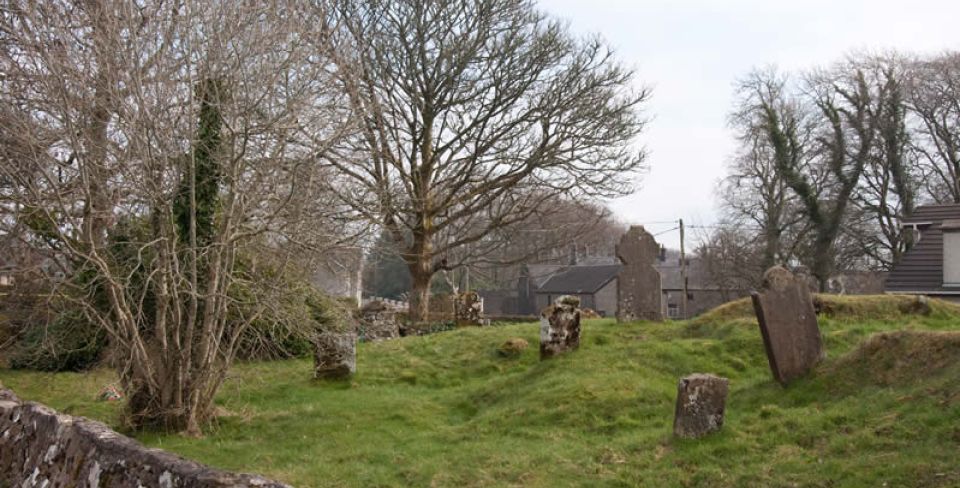5.5 Ballintemple
It is believed that the first church on this site was founded by St Adomnán (c.628-704), Abbot of the monastery at Iona from 679 to 704 and the author of the Life of St Columba.
According to tradition, Adomnán wanted to build his church two miles away at Lisnascreaghog but every time the walls were built, they fell down. Adomnán prayed about the problem but while he was praying, fell asleep. He woke to find an eagle flying away with his prayer book. The eagle dropped the book on this site and so Adomnán built his church here in Glenullin – Gleann an Iolair (the Eagle’s Glen).
There is a circular walk starting here which takes you to the nearby Glenullin woods, site of the Gortnamoyagh inauguration stone – also known as St Adomnán’s stone. The route of the walk is shown on an interpretation board at the church. You can also drive to Glenullin woods.
Inauguration stones were used during ceremonies to establish a ruler’s right to rule over the local area. There is a foot-shaped space imprinted in the stone where the chieftain is said to have placed his foot as a symbol of his commitment to the land. In Glenullin, the footprint is said to have been Adomnán’s, made as he stood to pray.
Footprints like these have been found at sites all over Ireland and Europe including Dunadd in Argyll, Scotland where there is a stone footprint linked to the kings of Dál Riata.
Today the remains of an early church lie in the centre of the graveyard. Outside the boundaries of the graveyard there is a souterrain which is now fenced off and inaccessible. This underground chamber was 15m long and 7m wide and may have been used as a store and also as a hiding place when the area was under attack.
North Sperrins and the Bann
- 5.1 Droim Ceat, Limavady
According to legend when Colmcille left Ireland it is said that he vowed never again to set foot on Irish soil. However he appears to have returned at least once - for the Convention of Drum Ceat probably in the 570s, here just south of Limavady. The event is recorded...
- 5.2 Giant’s Sconce
From the top of the Giant’s Sconce, it is easy to see why it would make a good place to build a fort. There are views in all directions and it is a short distance by land to the River Bann and the sea beyond. This monument is thought to...
- 5.3 St Patrick’s CofI, Coleraine
The earliest record of Coleraine appears in Adomnán’s Life of St Columba. Adomnán was an Abbot of Iona and wrote his account of Colmcille’s life a century after the saint’s death in 597. Adomnán mentions that Colmcille stayed with the Bishop of Coleraine on his way home from the Convention of Drum...
- 5.4 Camus
The red sandstone fragment of the early medieval Camus cross now stands in a graveyard on the west side of the River Bann to the south of Coleraine. The cross is carved with religious scenes on the front and back - the Ark and the murder of Abel on the...
- 5.5 Ballintemple
It is believed that the first church on this site was founded by St Adomnán (c.628-704), Abbot of the monastery at Iona from 679 to 704 and the author of the Life of St Columba. According to tradition, Adomnán wanted to build his church two miles away at Lisnascreaghog but every time the walls were...










Bòrd na Gàidhlig
Great Glen House
Leachkin Road
Inverness
Scotland, IV3 8NW
(+44) 01463 225454
colmcille@gaidhlig.scot
Colmcille
Foras na Gaeilge, 2-6 Queen Street
Belfast
Northern Ireland
BT1 6ED
(+44) 028 9089 0970
colmcille@forasnagaeilge.ie
Colmcille
Foras na Gaeilge, An Chrannóg
Na Doirí Beaga
Gaoth Dobhair
Donegal, Ireland. F92 EYT3
(+353) 074 9560113
colmcille@forasnagaeilge.ie


